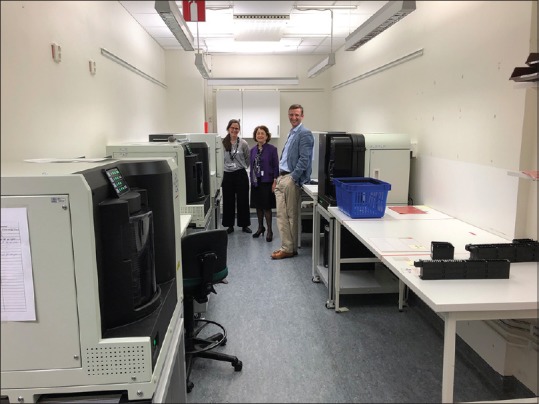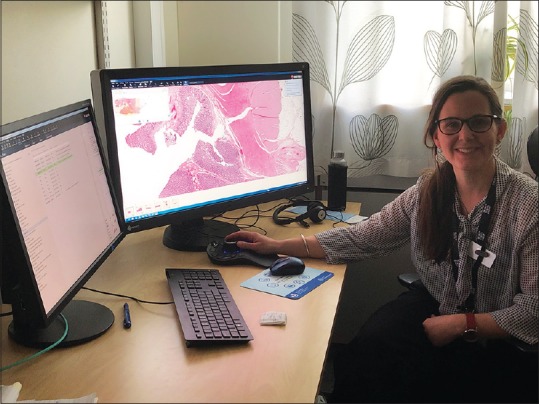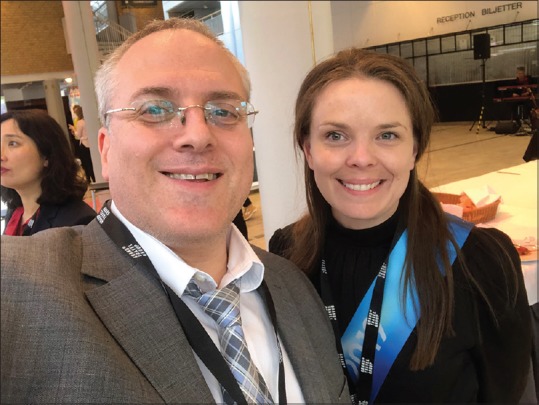It has been said that “Swedes are egalitarian in nature, humble and find boasting absolutely unacceptable. In many ways, Swedes prefer to listen to others as opposed to ensuring that their own voice is heard.”[1]
Dr. Liron Pantanowitz and Dr. Sylvia Asa recently had the opportunity to see the truth of this sentiment first hand. As invited speakers at the 2019 annual meeting of the Swedish Society for Pathology combined with the 6th Nordic Digital Pathology Symposium, they visited Linköping where the meeting was held, and while there, they were invited to tour the Pathology Department of the Linköping University Hospital.
The digital pathology program initiated by Dr. Sten Thorstenson in 2006[2] has been assumed by Dr. Anna Bodén, and with the help of Dr. Darren Treanor of Leeds in the UK, the group has moved ahead slowly and steadily to successfully implement a living version of a digital department of pathology.[3] Fully integrated with the SymPathy laboratory information system (LIS), whole-slide images of all routine surgical pathology cases are scanned by a suite of Hamamatsu scanners [Figure 1] that provide high-quality images of even large whole-mount sections that are being used for multiple applications in the laboratory. To date, the pathology department has scanned around 1.8 million slides, likely more than any other pathology department in the world. The Sectra viewer, developed with the expertise of Claes Lundström and team at Sectra, provides a workflow that any pathologist can manage. Image analysis programs are available at the click of the mouse. At this point, most pathologists use the digital system for various tasks including primary diagnosis. Microscopes have been moved away from their workstations and are instead replaced by a large monitor [Figure 2].
Figure 1.

Anna Bodén, Sylvia Asa, and Darren Treanor examine the suite of Hamamatsu scanners in the Linköping University Hospital
Figure 2.

Anna Bodén in her office with her pathologist's cockpit. The office does not have a microscope
The validity of a digital pathology department is proven by the fact that resident Sofia Jarkman [Figure 3] has only ever practiced surgical pathology using the digital system (she is a real digital native!) and finds that she has more confidence and comfort using it than the microscope. Now after graduating, Sofia is doing her PhD in the field of digital pathology and will start a job in the department of pathology in Linköping. Sofia has lived in this digital world since the beginning of her career and has not been biased by the old ways of doing things.
Figure 3.

Liron Pantanowitz and Sofia Jarkman attend the 2019 annual meeting of the Swedish Society for Pathology
While the Swedes have been silently leading the way in effectively utilizing digital pathology for primary diagnosis, they have been humble and quiet without boasting about their many and significant accomplishments. As early adopters, the team at Linköping have had to learn a lot over the years, and the improved processes, workflow, and software resulting from their efforts will make it easier for the rest of the world to follow.
It is interesting that, in 2006, both Sweden and Canada began their journeys using whole-slide imaging for pathology diagnosis,[2,3,4] and in both countries, the regulatory environment allowed them to push forward rapidly, implementing digital pathology with workflows for LIS integration and achieving primary diagnosis by 2010. However, the Swedes have truly achieved the goal of full adoption while they quietly marched forward with resolute determination.
In 2010, Dr. Asa titled her plenary talk at the annual Visions Conference in San Diego “2020 Vision of Pathology” and she predicted that, by 2020, pathologists would be signing out their cases using digital imaging technology without the need for a microscope. She had begun to fear that her prediction was wrong, but this trip to Sweden was the opportunity to see that this vision is alive and thriving.
Financial support and sponsorship
Nil.
Conflicts of interest
Claes Lundström is employed by Sectra.
Footnotes
Available FREE in open access from: http://www.jpathinformatics.org/text.asp?2019/10/1/27/264400
REFERENCES
- 1.Commisceo Global Commisceo Global. Sweden – Language, Culture, Customs, Etiquette and Business Protocol. [Last accessed on 2019 Jul 10]. Available from: https://www.commisceo-global.com/resources/country-guides/sweden-guide .
- 2.Thorstenson S. Digital pathology system. Case study. Adv Lab. 2010;19:69. [Google Scholar]
- 3.Thorstenson S, Molin J, Lundström C. Implementation of large-scale routine diagnostics using whole slide imaging in Sweden: Digital pathology experiences 2006-2013. J Pathol Inform. 2014;5:14. doi: 10.4103/2153-3539.129452. [DOI] [PMC free article] [PubMed] [Google Scholar]
- 4.Volynskaya Z, Chow H, Evans A, Wolff A, Lagmay-Traya C, Asa SL. Integrated pathology informatics enables high-quality personalized and precision medicine: Digital pathology and beyond. Arch Pathol Lab Med. 2018;142:369–82. doi: 10.5858/arpa.2017-0139-OA. [DOI] [PubMed] [Google Scholar]


